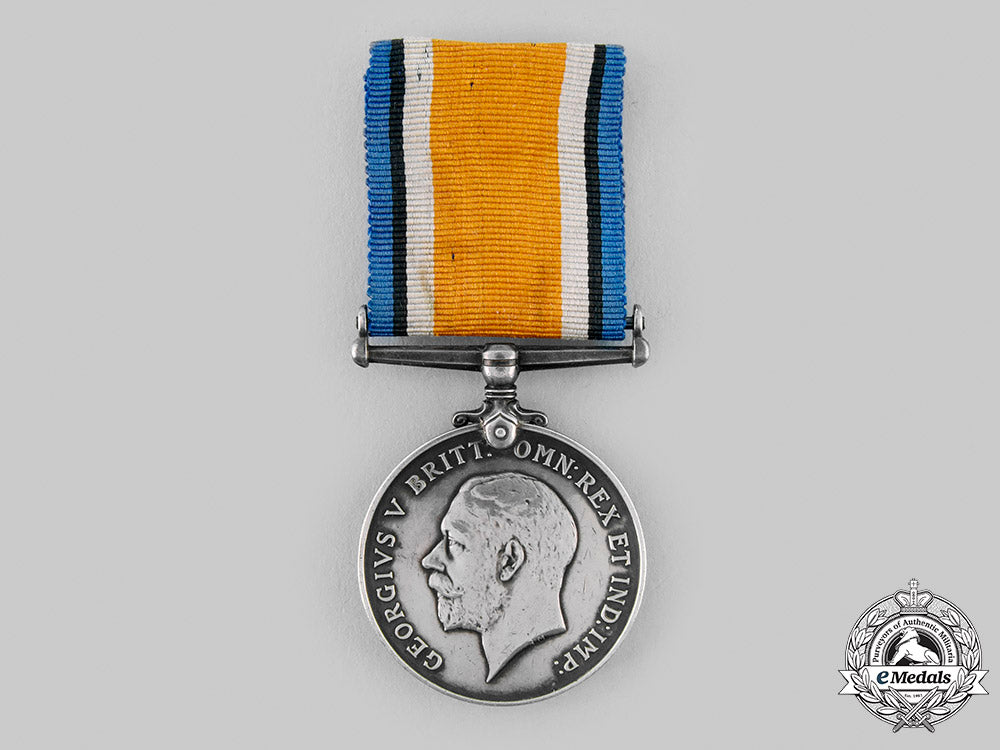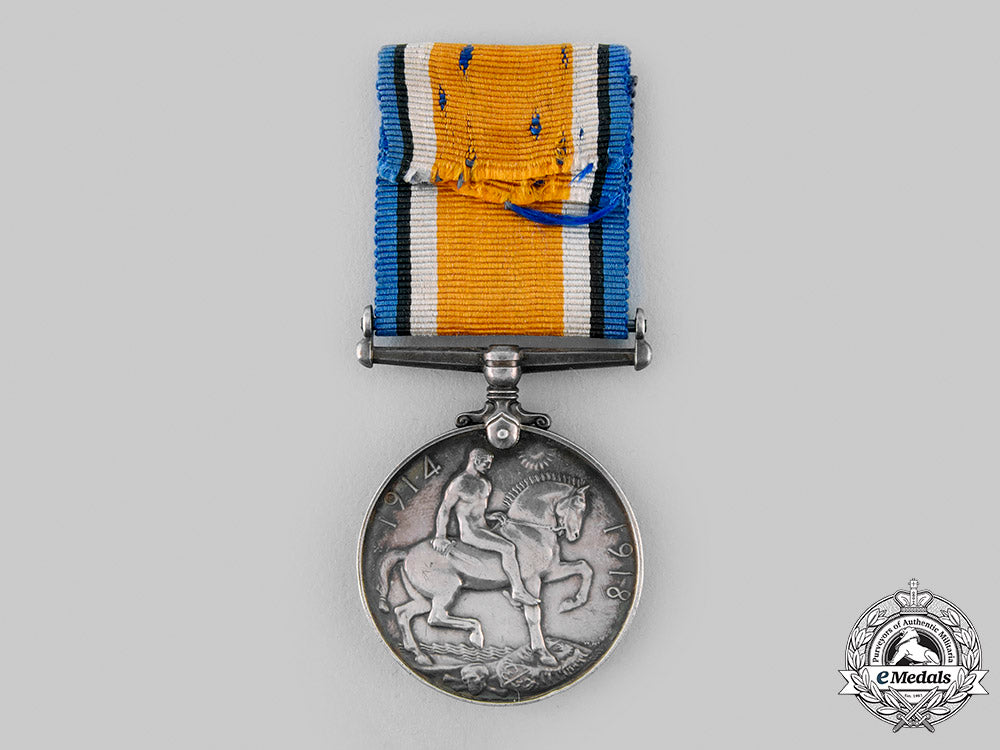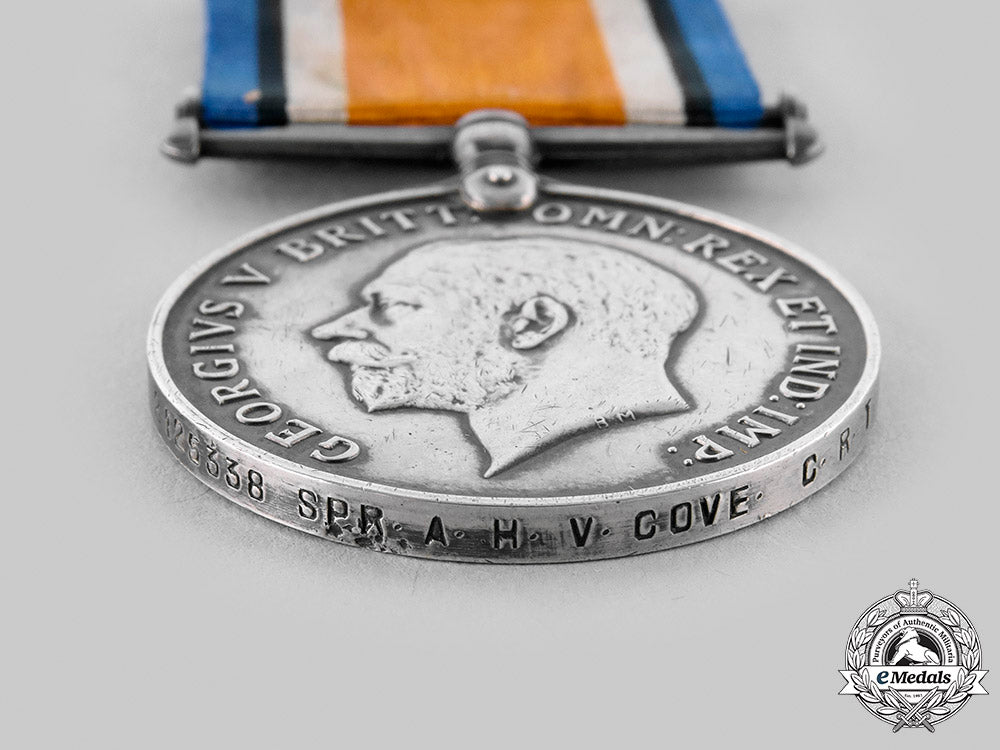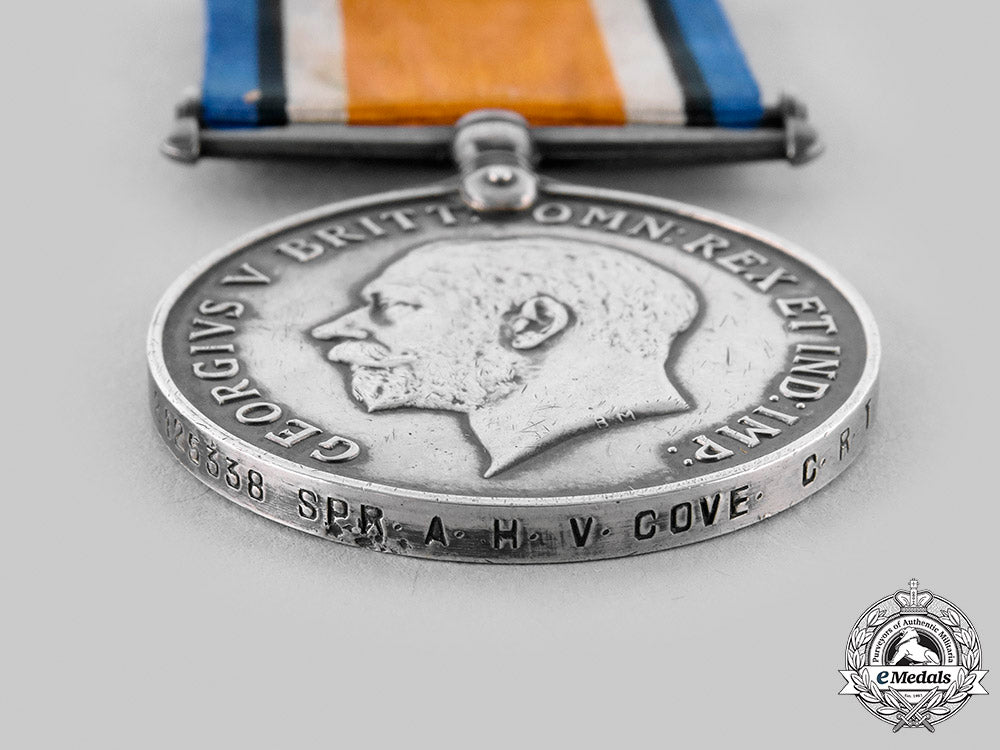
LOADING ...
In response to evolving domestic opinion, eMedals Inc has made the conscious decision to remove the presentation of German Third Reich historical artifacts from our online catalogue. For three decades, eMedals Inc has made an effort to preserve history in all its forms. As historians and researchers, we have managed sensitive articles and materials with the greatest of care and respect for their past and present social context. We acknowledge the growing sentiments put forth by the Canadian public and have taken proactive actions to address this opinion.



Canada, Cef. A British War Medal, Canadian Railway Troops
Canada, Cef. A British War Medal, Canadian Railway Troops
SKU: ITEM: C6135
Current Bid:
Your Max Bid:
Bid History:
Time Remaining:
Couldn't load pickup availability
Shipping Details
Shipping Details
eMedals offers rapid domestic and international shipping. Orders received prior to 12:00pm (EST) will be shipped on the same business day.* Orders placed on Canadian Federal holidays will be dispatched the subsequent business day. Courier tracking numbers are provided for all shipments. All items purchased from eMedals can be returned for a full monetary refund or merchandise credit, providing the criteria presented in our Terms & Conditions are met. *Please note that the addition of a COA may impact dispatch time.
Shipping Details
eMedals offers rapid domestic and international shipping. Orders received prior to 12:00pm (EST) will be shipped on the same business day.* Orders placed on Canadian Federal holidays will be dispatched the subsequent business day. Courier tracking numbers are provided for all shipments. All items purchased from eMedals can be returned for a full monetary refund or merchandise credit, providing the criteria presented in our Terms & Conditions are met. *Please note that the addition of a COA may impact dispatch time.
Description
Description
(2125338 SPR. A.H.V. COVE. C.R.T.). Naming is officially impressed. Bruised, edge nicks, contact marks, original ribbon, fine. Accompanied by copies of his Index Cards, Attestation Paper, Service Records, Medical Records, Pay Records and Discharge Certificates.
Footnote: Arthur Henry Victor Cove was born on November 10, 1885 in Chipping Sodbury, South Gloucestershire, England, the son of Mark Cove and Elizabeth Cove, both later of Oakridge, Gloucestershire. He left school at the age of 15 after having completed 7th Standard, then worked as a pantry boy for nine months, followed by employment as a Locomotive Cleaner for two and a half years. He immigrated to Canada and began working as a Fireman on the Grand Trunk Railway for four years, until he enlisted. Cove was a resident of London, Ontario when he signed his Attestation Paper as a Sapper (2125338) with No. 2 Section, Skilled Railway Employees, on March 15, 1917 in London, at the age of 31, naming his next-of-kin as his wife, Gertrude Cove of London, stating that he had no previous military service, that he was Married, that his religion was Church of England and that his trade was that of Locomotive Fireman. He and his wife had no children. During his medical examination, the physician noted that Cove had tattoos of a bracelet and flowers on his right breast, along with coiled serpents on his left forearm. At the time of enlistment, his father, mother and sister were alive. He was posted to the Mobilization Centre at Military District No. 4 in Montreal, Quebec on March 20, 1917. Sapper Cove embarked from Halifax, Nova Scotia aboard the HMT Grampian on April 16, 1917, arriving in England on the 29th.
Just shy of two months later, he was still with No. 2 Section, Skilled Railway Employees CEF and posted to Aldershot when he received his orders to proceed for service in the French theatre on June 9, 1917. He departed Southampton and arrived in Le Havre, France on June 10th. No. 2 Section, Skilled Railway Employees CEF was soon re-designated as No. 13 Light Railway Operating Company, Royal Engineers, with Cove assuming the position of Fireman. Sapper Cove was under fairly heavy shell fire, when he was "badly shaken up" from twelve hours of bombardment on July 10, 1917. One of the physicians would later note that he was "slightly shaky and did not seem to get along well" and that he "gradually got worse, becoming very jumpy, even with 'our own guns' ". He reported "sick" to No. 39 Casualty Clearing Station on August 28, 1917 after twenty-three hours more of bombardment but "was not blown up", his condition was stated as "NYD" (Not Yet Determined). He soon found himself transferred to No. 36 Casualty Clearing Station, then was transferred for a second time, admitted to No. 34 Casualty Clearing Station on September 19, 1917. He would remain here for five days, before being discharged to duty on September 24th. Three months would pass before he would seek hospitalization again, initially treated at 2/1st North Midland Field Ambulance on December 26, 1917 for a "Debility", then discharged to duty on the 27th. Late that winter and early in the new year, he was hospitalized for a third time, as he was admitted to No. 29 Casualty Clearing Station on March 4, 1918, diagnosed with "D.A.H." (Disordered Action of the Heart, otherwise known as Soldier's Heart or Effort Syndrome, and was thought to result from a combination of over exertion, mental stress and fatigue). He had been working at the first lines under shell fire from October 31, 1917 until March 4, 1918 and had become "very shaky and got very weak, had dreams, etc.". Three days later, he was transferred to No. 2 Stationary Hospital at Abbeville on March 7th for more assessment. The decision was made over a week later to invalid him to England, where he was posted to the Canadian Reserve Training Depot on March 16th. He was admitted to Berrington War Hospital at Shrewsbury, Shropshire on March 16, 1918, which was attached to the Auxiliary Military Hospital at Ardmillan, Oswestry, Shropshire. After two months treatment at Shrewsbury, he was transferred and admitted to the Granville Canadian Special Hospital at Buxton on June 18, 1918, still designated with "D.A.H." (Disordered Action of the Heart). He would remain at Buxton for an additional three months of recuperation, before being struck off strength of the Overseas Military Forces of Canada to the CEF in Canada, invalided to Canada aboard the S.S. Neuralia on September 20, 1918 and arriving in Halifax on October 1st.
By the time he arrives in Canada, he was officially diagnosed with "Neurasthenia" (mechanical weakness of the actual nerves) and was taken on strength from overseas, then posted to the Hospital Section. Sapper Cove was then transferred and posted to the No. 2 District Depot in Toronto, Ontario on October 28, 1918, where one of the physicians stated that "he complains 'I am suffering from nerves' ". He was posted to the Casualty Company at the Canadian Convalescent Depot on October 5, 1918 and admitted to the Central Military Convalescent Hospital (CMCH) in Toronto on October 21st. In his Medical History of an Invalid, dated November 26, 1918 at the Central Military Convalescent Hospital in Toronto, in regards to his "Neurasthenia", the attending physician noted that Sapper Cove's disability was due to partial loss of function of his nervous system and summarized his patient's condition as follows, that Cove was in "France as (a) Fireman in light railway under shell fire from 10-6-17 (June 10, 1917) to 28-8-17 (August 28, 1917) [2 1/2 months], gradually has been getting jumpy and after a 12 hour bombardment, reported sick complaining of being shaky, headaches and jumpy. Was in hospital with D.A.H. (Disordered Action of the Heart) and returned to (his) unit (in) October 1917. Carried on until March 7, 1918 when he got very weak and shaky, dreams, sleeping poorly, invalided to Canada". He also stated that Cove had "Neurasthenia" prior to enlistment, that it was not aggravated by his war service and that he would have "no disability" in civilian life. His medical records also indicate some truths: that Cove had "no serious illness before enlistment", that he had "Bronchitis" and was off duty for thirteen days before enlistment, and that he "has always felt nervous and startles easily". The Medical Board recommended "that (the) patient be discharged on account of medical {emotional} unfitness" and that he be placed in Category "E" (Unfit for service in Categories A, B and C = General Service, Service Abroad, Home Service). Sapper Arthur Henry Victor Cove, Canadian Railway Troops was struck off strength and discharged as "having been found medically unfit for service" at No. 2 District Depot in Toronto, on December 6, 1918, credited with having served in Canada, England, France and Belgium. For his First World War service, he was awarded the British War Medal and the Victory Medal.
Description
(2125338 SPR. A.H.V. COVE. C.R.T.). Naming is officially impressed. Bruised, edge nicks, contact marks, original ribbon, fine. Accompanied by copies of his Index Cards, Attestation Paper, Service Records, Medical Records, Pay Records and Discharge Certificates.
Footnote: Arthur Henry Victor Cove was born on November 10, 1885 in Chipping Sodbury, South Gloucestershire, England, the son of Mark Cove and Elizabeth Cove, both later of Oakridge, Gloucestershire. He left school at the age of 15 after having completed 7th Standard, then worked as a pantry boy for nine months, followed by employment as a Locomotive Cleaner for two and a half years. He immigrated to Canada and began working as a Fireman on the Grand Trunk Railway for four years, until he enlisted. Cove was a resident of London, Ontario when he signed his Attestation Paper as a Sapper (2125338) with No. 2 Section, Skilled Railway Employees, on March 15, 1917 in London, at the age of 31, naming his next-of-kin as his wife, Gertrude Cove of London, stating that he had no previous military service, that he was Married, that his religion was Church of England and that his trade was that of Locomotive Fireman. He and his wife had no children. During his medical examination, the physician noted that Cove had tattoos of a bracelet and flowers on his right breast, along with coiled serpents on his left forearm. At the time of enlistment, his father, mother and sister were alive. He was posted to the Mobilization Centre at Military District No. 4 in Montreal, Quebec on March 20, 1917. Sapper Cove embarked from Halifax, Nova Scotia aboard the HMT Grampian on April 16, 1917, arriving in England on the 29th.
Just shy of two months later, he was still with No. 2 Section, Skilled Railway Employees CEF and posted to Aldershot when he received his orders to proceed for service in the French theatre on June 9, 1917. He departed Southampton and arrived in Le Havre, France on June 10th. No. 2 Section, Skilled Railway Employees CEF was soon re-designated as No. 13 Light Railway Operating Company, Royal Engineers, with Cove assuming the position of Fireman. Sapper Cove was under fairly heavy shell fire, when he was "badly shaken up" from twelve hours of bombardment on July 10, 1917. One of the physicians would later note that he was "slightly shaky and did not seem to get along well" and that he "gradually got worse, becoming very jumpy, even with 'our own guns' ". He reported "sick" to No. 39 Casualty Clearing Station on August 28, 1917 after twenty-three hours more of bombardment but "was not blown up", his condition was stated as "NYD" (Not Yet Determined). He soon found himself transferred to No. 36 Casualty Clearing Station, then was transferred for a second time, admitted to No. 34 Casualty Clearing Station on September 19, 1917. He would remain here for five days, before being discharged to duty on September 24th. Three months would pass before he would seek hospitalization again, initially treated at 2/1st North Midland Field Ambulance on December 26, 1917 for a "Debility", then discharged to duty on the 27th. Late that winter and early in the new year, he was hospitalized for a third time, as he was admitted to No. 29 Casualty Clearing Station on March 4, 1918, diagnosed with "D.A.H." (Disordered Action of the Heart, otherwise known as Soldier's Heart or Effort Syndrome, and was thought to result from a combination of over exertion, mental stress and fatigue). He had been working at the first lines under shell fire from October 31, 1917 until March 4, 1918 and had become "very shaky and got very weak, had dreams, etc.". Three days later, he was transferred to No. 2 Stationary Hospital at Abbeville on March 7th for more assessment. The decision was made over a week later to invalid him to England, where he was posted to the Canadian Reserve Training Depot on March 16th. He was admitted to Berrington War Hospital at Shrewsbury, Shropshire on March 16, 1918, which was attached to the Auxiliary Military Hospital at Ardmillan, Oswestry, Shropshire. After two months treatment at Shrewsbury, he was transferred and admitted to the Granville Canadian Special Hospital at Buxton on June 18, 1918, still designated with "D.A.H." (Disordered Action of the Heart). He would remain at Buxton for an additional three months of recuperation, before being struck off strength of the Overseas Military Forces of Canada to the CEF in Canada, invalided to Canada aboard the S.S. Neuralia on September 20, 1918 and arriving in Halifax on October 1st.
By the time he arrives in Canada, he was officially diagnosed with "Neurasthenia" (mechanical weakness of the actual nerves) and was taken on strength from overseas, then posted to the Hospital Section. Sapper Cove was then transferred and posted to the No. 2 District Depot in Toronto, Ontario on October 28, 1918, where one of the physicians stated that "he complains 'I am suffering from nerves' ". He was posted to the Casualty Company at the Canadian Convalescent Depot on October 5, 1918 and admitted to the Central Military Convalescent Hospital (CMCH) in Toronto on October 21st. In his Medical History of an Invalid, dated November 26, 1918 at the Central Military Convalescent Hospital in Toronto, in regards to his "Neurasthenia", the attending physician noted that Sapper Cove's disability was due to partial loss of function of his nervous system and summarized his patient's condition as follows, that Cove was in "France as (a) Fireman in light railway under shell fire from 10-6-17 (June 10, 1917) to 28-8-17 (August 28, 1917) [2 1/2 months], gradually has been getting jumpy and after a 12 hour bombardment, reported sick complaining of being shaky, headaches and jumpy. Was in hospital with D.A.H. (Disordered Action of the Heart) and returned to (his) unit (in) October 1917. Carried on until March 7, 1918 when he got very weak and shaky, dreams, sleeping poorly, invalided to Canada". He also stated that Cove had "Neurasthenia" prior to enlistment, that it was not aggravated by his war service and that he would have "no disability" in civilian life. His medical records also indicate some truths: that Cove had "no serious illness before enlistment", that he had "Bronchitis" and was off duty for thirteen days before enlistment, and that he "has always felt nervous and startles easily". The Medical Board recommended "that (the) patient be discharged on account of medical {emotional} unfitness" and that he be placed in Category "E" (Unfit for service in Categories A, B and C = General Service, Service Abroad, Home Service). Sapper Arthur Henry Victor Cove, Canadian Railway Troops was struck off strength and discharged as "having been found medically unfit for service" at No. 2 District Depot in Toronto, on December 6, 1918, credited with having served in Canada, England, France and Belgium. For his First World War service, he was awarded the British War Medal and the Victory Medal.



You May Also Like
Japan, Empire. A T90 Civil Defense Helmet, c.1943
W8287
Germany, SA. A Model 1933 Service Dagger, SA-Gruppe Nordsee, by Friedrich von der Kohlen
G59818
Germany, SA. A Model 1933 Service Dagger, SA-Gruppe Pommern, by Gustav Wirth
G59816
Germany, Third Reich. A Mixed Lot of Tyrolean Marksmanship Badges
G52930
Germany, SS. An Estonian Waffen-SS Volunteer’s Sleeve Shield
G50381
-
Japan, Empire. A T90 Civil Defense Helmet, c.1943
W8287
Add to CartRegular price $275 USDRegular price $0 USD Sale price $275 USDUnit price / per -
Germany, SA. A Model 1933 Service Dagger, SA-Gruppe Nordsee, by Friedrich von der Kohlen
G59818
Add to CartRegular price $980 USDRegular price $0 USD Sale price $980 USDUnit price / per -
Germany, SA. A Model 1933 Service Dagger, SA-Gruppe Pommern, by Gustav Wirth
G59816
Add to CartRegular price $980 USDRegular price $0 USD Sale price $980 USDUnit price / per -
Germany, Third Reich. A Mixed Lot of Tyrolean Marksmanship Badges
G52930
Add to CartRegular price $135 USDRegular price $0 USD Sale price $135 USDUnit price / per -
Germany, SS. An Estonian Waffen-SS Volunteer’s Sleeve Shield
G50381
Add to CartRegular price $150 USDRegular price $0 USD Sale price $150 USDUnit price / per
Do you have a similar item you are interested in selling?
Please complete the form and our client care representatives will contact you.
Sell Item










